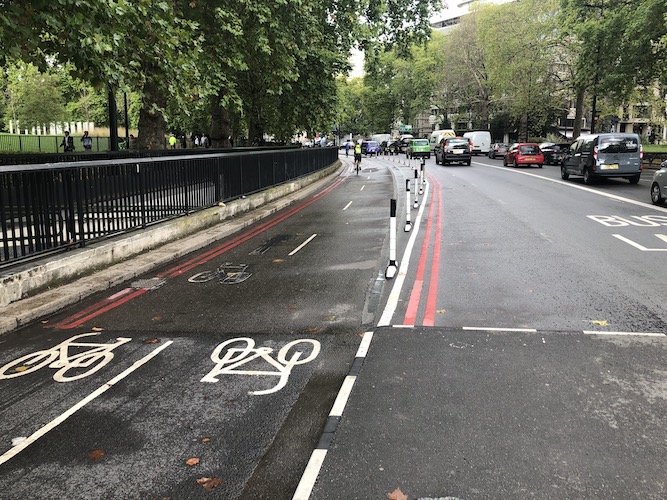On 22 August an email was sent out from Transport for London about the segregated lane for bicycles that was installed along Park Lane in May 2020 as part of its Streetspace programme responding to the onset of the pandemic. Like other Streetspace projects it was described as “temporary”, with the proviso that it might be made permanent in future.
A two-way track on the northbound carriageway of Park Lane running parallel with the eastern edge of Hyde Park, it is still there two-and-half years later and TfL’s email, sent out by its Strategic Consultations team, said its purpose was to “explain in more detail why we believe the changes we made to Park Lane during the pandemic should be improved and retained permanently”.
The email anticipates a question: “How do you know that more people will cycle in London and in Park Lane.” It then offers an answer, part of which is: “There are nearly 20 per cent more trips on bikes this year than there were in 2021.”
What exactly does that mean? Does it mean nearly 20 per cent more “trips on bikes” in the whole of Greater London, the whole of that part of central London or just the whole of Park Lane? Does it mean that there had already in 2022, just two-thirds of the way through it, been “nearly 20 per cent more trips on bikes” than there were in the whole of 2021, or only during January to August of that year? And if “nearly 20 per cent more” is specifically about bicycles travelling along Park Lane, what is the change in the actual number compared with 2021? “Nearly 20 per cent” is a large percentage increase, but what if it’s only “nearly 20 per cent more” of not very many?
Further on, the email says “there have been 2,400 cycle trips on Park Lane”, but it does not say over what period or how that number compares with the same or other comparable periods in the past. Without providing that information the figure of 2,400 cycle trips is meaningless in terms of trying to assess how busy the cycle lane is and to what extent, if any, it has encouraged more cycling along Park Lane than there was before.
I promise this is not me, a bit of a sceptic about the efficacy of cycle lanes for fostering more cycling, being peevish or pedantic. Imprecise and selective use of statistics has been characteristic of TfL’s (and City Hall’s) attempts to promote cycling since the advent of Streetspace if not before, sometimes giving the impression of huge increases which might be questionable.
The email about Park Lane ends saying “there will a public consultation starting in the autumn” about the Park Lane scheme (which also includes a bus lane), and promises to provide “further details once the consultation has launched”.
I will be looking for far more robust statistics about cycling than the email of 22 August contains. Ideally, I would like to be given actual numbers – not just percentage changes – of bicycles travelling along the segregated cycle lane over specified recent periods – daily, monthly and so on – and actual numbers of bicycles that travelled along Park Lane, both northbound and southbound, during the equivalent specified periods previously, including, crucially, before the cycle lane was introduced.
A reasonable like-with-like comparison might then be possible, as part of considering a range of issues, such as the scheme’s effects on motor traffic congestion and air pollution – which opponents believe it has worsened – and how many cyclists, if any, have stopped using the Broad Walk path close by within Hyde Park and started using the Park Lane track instead. On that last point, TfL’s email said: “We have already seen a switch of people cycling on Park Lane rather than Broad Walk and if the cycle lanes are kept on Park Lane we can encourage more cyclists out of Hyde Park.”
I asked TfL about the “nearly 20 per cent” increase mentioned in the consultation team’s email. Surely if such an increase has taken place in 2022 since however much of 2021 it is being compared with, TfL must have actual numbers for 2022 and the relevant period of 2021 readily to hand. Otherwise, how can they possibly have worked out a percentage difference between the two?
However, TfL said they couldn’t help me, at least not straight away. They did, though, add that a report about all the data relating to the scheme is being compiled and will be completed early next month. Hopefully, the figures Londoners need in order to make informed assessments about the effects of the Park Lane cycle scheme will soon be in the public domain.
On London strives to provide more of the kind of journalism the capital city needs. Become a supporter for just £5 a month. You will even get things for your money. Details here.
